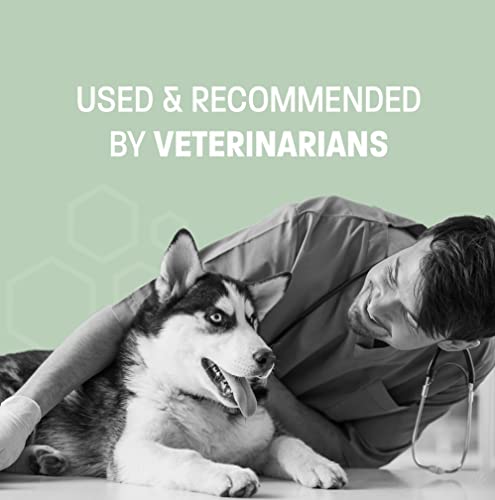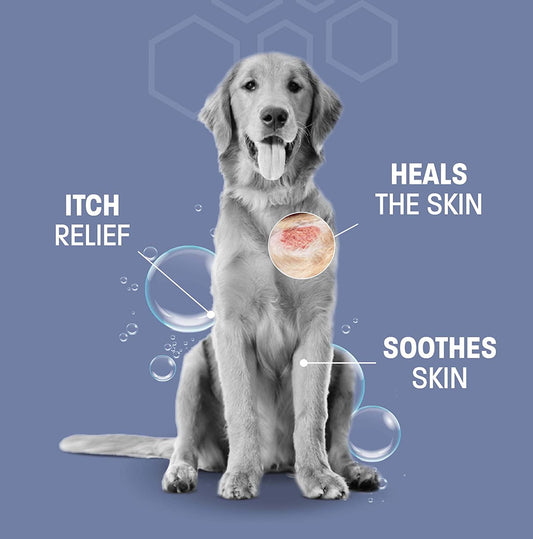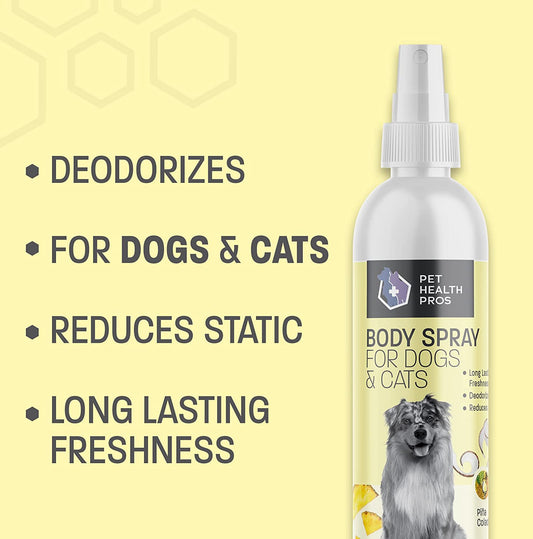Skin conditions in dogs can often look similar, causing confusion for pet owners. Pet Health Pros offers a comprehensive guide to distinguishing ringworm from other common canine skin ailments and introduces our medicated products to aid in total pet health.
Ringworm, a skin condition in dogs, can be mistaken for other similar issues. Knowing the differences is vital for pet owners. By spotting and treating ringworm, owners can give their dogs what they need.
It's a fungal infection causing circles on the skin. It can look like eczema or dermatitis. But, it's contagious and can spread to humans or other animals. So, it needs to be found and treated quickly.
Ketoconazole is a common antifungal medication used to fight the fungus causing the infection. Also, topical antiseptics with chlorhexidine can help clean the affected areas. This stops bacterial infections.
It's not only dogs with weak immune systems or poor hygiene that get ringworm. Good hygiene and grooming can lower the chances of getting it. The Taking precautions and acting promptly can keep our furry friends healthy.
What is Ringworm?
Ringworm is a common fungal infection that affects humans and animals. It is caused by a group of fungi called dermatophytes. These grow in warm and moist places, which makes dogs vulnerable.
Let's look at its signs and how it is spread. Circular or irregular-shaped patches on the dog's skin with red edges may appear. These could be itchy or scaly. It spreads through contact with an infected dog or via objects like bedding, brushes, or furniture.
To treat it, consult a vet. Usually, antifungal meds such as ketoconazole are prescribed. These stop the growth of fungi, getting rid of the infection.
In addition to medication:
- Keep the environment clean and disinfect regularly with antiseptic or antibacterial products. This kills spores and stops re-infection.
- Bathe the dog with an antifungal shampoo. This reduces fungi on the skin and helps healing.
Clean or replace the bedding, toys, and grooming equipment. This stops it from spreading.
If you follow these steps and get proper treatment, you can fight ringworm. Remember that early detection and prompt action are key!
Other Skin Conditions in Dogs
Skin conditions in dogs can be overwhelming. They can manifest in various forms, leading to discomfort and concern for their owners. To treat them effectively, it's essential to identify the specific condition.
One example is dermatitis. It's an inflammation of the skin, caused by environmental allergens or irritants. Symptoms include redness, itching, and sores. Allergic reactions to food or substances can also cause it.
Seborrhea is another common skin condition. It's characterized by excessive oil production, resulting in flaky skin and a bad smell. It can be a primary problem, or secondary to underlying issues like hormonal imbalances or allergies.
Pyoderma is a bacterial infection of the skin. It leads to pustules and pus-filled bumps. It's usually caused by Staphylococcus, and presents with redness, swelling, and discomfort.
Other skin conditions include fungal infections like ringworm and yeast infections. These cause itchy rashes and hair loss.
Comparing Ringworm with Other Skin Conditions
Ringworm is a prevalent skin ailment affecting dogs. It may be mistaken for other skin issues due to similar symptoms. However, there are distinct differences that can help owners identify and treat it properly.
The source of the infection is one major distinction between ringworm and other skin conditions. It is caused by a fungus called Dermatophytes, unlike other skin issues which may be caused by bacteria or allergies. This is important as it determines the type of treatment necessary.
For ringworm, antifungal medications are usually used. These contain ketoconazole, an active ingredient that targets fungal growth. Whereas, antibacterial or antiseptic treatments are more often used for bacterial infections or general skin irritations.
Additionally, antifungal shampoos and sprays are helpful in distinguishing ringworm from other skin conditions. These generally contain chlorhexidine, an antifungal component. By using them, owners can combat ringworm and stop its spread to other pets or people.
Treatment Options for Ringworm and Other Skin Conditions
Ringworm and other skin conditions can be treated. Here are some options:
- Antiseptic and antibacterial solutions to kill bacteria and stop spread of infection.
- Medications with active ingredients such as ketoconazole to target fungi.
- Chlorhexidine baths for cleaning and relief from itching.
It's important to note that each dog responds differently. So, consult the vet for tailored advice.
Early detection and treatment are crucial. Consult professionals for help in keeping your pet healthy.
Preventive Measures for Ringworm and Other Skin Conditions
Preventing skin conditions in dogs is key! It's easy to take preventive measures to help protect your pup. Here are some things to consider:
- Clean and groom your dog's coat often. This helps remove dirt, dead skin cells, and excess oil that can cause fungi and bacteria to grow.
- Use antiseptic and antibacterial products when bathing. Look for ingredients like chlorhexidine, which kills a wide range of microbes.
- Don't share items with other dogs, like bedding or grooming tools. Make sure to regularly wash and disinfect them.
- If you think your dog has been exposed to ringworm or another skin condition, talk to a vet. They may suggest using antifungal treatments, like ketoconazole.
Remember, overall health is also important. Give your pup a balanced diet, exercise, and necessary vaccinations.
Fun fact: ringworm isn't caused by worms, but rather by a group of fungi called dermatophytes. These tiny organisms cause the circular rashes associated with the condition.
Conclusion
Correct identification and treatment are key. Trust in Pet Health Pros and our medicated product line to provide the care your dog needs.
When managing ringworm in dogs, antiseptic, antibacterial, and antifungal treatments are key. Ketoconazole and chlorhexidine are great for tackling fungal infections. But, always see a vet for a diagnosis and treatment recommendation. They will provide the best guidance on how to use the medication, and how often. Also, bathing your pup regularly with the right shampoo, and keeping their environment clean, can help prevent skin conditions. Taking care of your dog's skin health ensures their happiness and wellbeing!
Frequently Asked Questions
Q: What is ringworm?
A: Ringworm is a highly contagious fungal infection that can affect the skin, hair, and nails of both humans and animals, including dogs. It appears as circular patches of red, scaly skin.
Q: How is ringworm different from other skin conditions?
A: Unlike many other common skin conditions, ringworm is caused by a fungus, not bacteria or viruses. It requires specific antifungal treatment to eliminate the infection.
Q: Can I use an antiseptic or antibacterial product to treat ringworm?
A: While antiseptics and antibacterial products can help prevent secondary infections, they are not effective in treating ringworm directly. You should consult a veterinarian for appropriate antifungal treatments.
Q: What is ketoconazole and how is it used to treat ringworm?
A: Ketoconazole is an antifungal medication commonly used to treat ringworm in both humans and dogs. It works by inhibiting the growth of the fungus responsible for the infection.
Q: What is chlorhexidine and how is it used in ringworm treatment?
A: Chlorhexidine is an antiseptic and disinfectant commonly used in ringworm treatment to cleanse the affected areas and prevent the spread of the infection. It is often found in medicated shampoos or wipes.
Q: Can ringworm be transmitted from dogs to humans?
A: Yes, ringworm can be transmitted from dogs to humans through direct contact with infected skin or hair. It is important to practice good hygiene, wear protective clothing, and regularly clean and disinfect the environment to prevent its spread.








